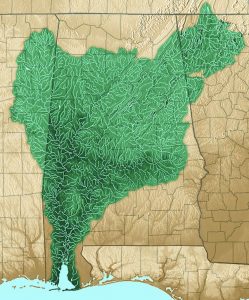CLICK HERE TO TAKE ACTION NOW!
“The Mobile Bay Basin is one of the richest natural resources favoring any state. It contains some of the most varied and beautiful sites in America, and its fauna and flora are biologically one of the richest, if not the richest, in North America. As a seven-generation Mobilian whose career as a scientist and writer was stamped by this environment, I am heartbroken to see any failure to halt its ongoing erosion.”
-Edward O. Wilson, University Research Professor Emeritus, Harvard University
Mobile Bay Rivers Among America’s Most Endangered Rivers® of 2017
 Contacts:
Contacts:
Ben Emanuel, American Rivers, 404-373-3980
Mitch Reid, Alabama Rivers Alliance, 205-322-6395
CLICK HERE FOR MORE INFORMATION.
Washington, D.C. – American Rivers today named the Mobile Bay River Basin among America’s Most Endangered Rivers®, shining a national spotlight on the threat poor water management poses to the drinking water supplies of millions and the region’s unique natural heritage.
“The America’s Most Endangered Rivers report is a call to action to save rivers that face a critical decision in the next year,” said Ben Emanuel, Clean Water Supply Director with American Rivers. “For the sake of the region’s clean drinking water, economy and irreplaceable natural heritage, the State of Alabama must stop wasteful water use and adopt a plan for responsible stewardship of these rivers.”
The Mobile Bay, its Delta and the rivers that sustain them– including the Black Warrior, Tombigbee, Alabama, Coosa, Tallapoosa and Cahaba Rivers– are threatened by rampant mismanagement of water resources. Throughout the Basin, river flows are increasingly being altered in an effort to accommodate excessive use and consumption. In Alabama, which is responsible for the vast majority of the watershed, the state does not measure or manage the use of water at all. In 2016, Alabama’s mismanagement of water resources throughout the summer resulted in over ten percent of the watershed’s streams setting new record low flows due to unchecked water consumption and a failure to address water shortages at the state level. As droughts and over consumption have increased in recent years, the State of Alabama has been too slow to act.
“Alabama has been working towards a sustainable water plan for years,” said Cindy Lowry, Executive Director of the Alabama Rivers Alliance. “The future generations of our state are depending on us to make the right decisions today. The health of the entire Mobile Basin ecosystem is essential for the people of Alabama and our economy. Now is the time to defend this critical Alabama re source.”
source.”
American Rivers and its partners are calling on the Alabama legislature to pass legislation that provides for sustainable water management throughout the Mobile Bay Basin. Specifically, this water management program must require the state to identify and reserve from allocation the flows and levels necessary to protect the chemical, physical and biological integrity of the state’s waters. This should include real provisions for accounting for water use, and describe the steps that the state will take in order to ensure that streams, as well as water users, are protected during future droughts and water shortages.
“Droughts and water shortages are becoming more common and more severe. Alabama can no longer afford to mismanage and squander its resources,” said Mitch Reid with Alabama Rivers Alliance.
Four of Alabama’s largest cities— Birmingham, Tuscaloosa, Montgomery and Mobile— as well as large portions of the Atlanta Metro Area, rely on Mobile Bay rivers for drinking water. The basin’s rivers are important for seafood, navigation, power generation, irrigation and recreation, including fishing, boating and whitewater kayaking. The Port of Mobile alone accounts for an estimated $22 billion in total economic impact, while outdoor recreation brings in $7.5 billion in direct consumer spending to Alabama. Described by E.O. Wilson as “America’s Amazon,” the basin, particularly the Mobile Delta, is home to hundreds of species of fish, crayfish, mussels, snails and other aquatic lifeforms, many of which are found nowhere else on earth.
In its 32nd year, the annual America’s Most Endangered Rivers report is a list of rivers at a crossroads, where key decisions in the coming months will determine the rivers’ fates. Over the years, the report has helped spur many successes including the removal of outdated dams, the protection of rivers with Wild and Scenic designations, and the prevention of harmful development and pollution.
Other area rivers recently listed as endangered include the Apalachicola-Chattahoochee-Flint Basin (#1 in 2016), Pascagoula (2016), Pearl (2015), Black Warrior (2011 and 2013) and Coosa (2010).
America’s Most Endangered Rivers® of 2017:
#1: Lower Colorado River (Arizona, California, Nevada)
Threat: Outdated water management and excessive diversions
#2: Bear River (California)
Threat: New Dam
#3: South Fork Skykomish (Washington)
Threat: New hydropower project
#4: Mobile Bay Rivers (Alabama, Georgia, Mississippi)
Threat: Poor water management
#5: Rappahannock River (Virginia)
Threat: Fracking
#6: Green-Toutle River (Washington)
Threat: New mine
#7: Neuse and Cape Fear Rivers (North Carolina)
Threat: Pollution from hog and chicken farms
#8: Middle Fork Flathead River (Montana)
Threat: Oil transport by rail
#9: Buffalo National River (Arkansas)
Threat: Pollution from massive hog farm
#10: Menominee River (Michigan, Wisconsin)
Threat: Open pit sulfide mining
###
About American Rivers
American Rivers protects wild rivers, restores damaged rivers, and conserves clean water for people and nature. Since 1973, American Rivers has protected and restored more than 150,000 miles of rivers through advocacy efforts, on-the-ground projects, and an annual America’s Most Endangered Rivers® campaign. Headquartered in Washington, DC, American Rivers has offices across the country and more than 250,000 members, supporters, and volunteers.
CLICK HERE TO READ THE FULL REPORT FROM AMERICAN RIVERS.


